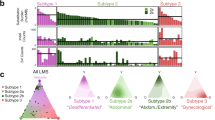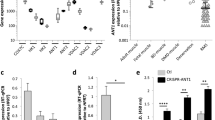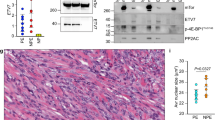Abstract
Many common human mesenchymal tumors, including gastrointestinal stromal tumor (GIST), rhabdomyosarcoma (RMS) and leiomyosarcoma (LMS), feature myogenic differentiation1,2,3. Here we report that intragenic deletion of the dystrophin-encoding and muscular dystrophy–associated DMD gene is a frequent mechanism by which myogenic tumors progress to high-grade, lethal sarcomas. Dystrophin is expressed in the non-neoplastic and benign counterparts of GIST, RMS and LMS tumors, and DMD deletions inactivate larger dystrophin isoforms, including 427-kDa dystrophin, while preserving the expression of an essential 71-kDa isoform. Dystrophin inhibits myogenic sarcoma cell migration, invasion, anchorage independence and invadopodia formation, and dystrophin inactivation was found in 96%, 100% and 62% of metastatic GIST, embryonal RMS and LMS samples, respectively. These findings validate dystrophin as a tumor suppressor and likely anti-metastatic factor, suggesting that therapies in development for muscular dystrophies may also have relevance in the treatment of cancer.
This is a preview of subscription content, access via your institution
Access options
Subscribe to this journal
Receive 12 print issues and online access
$209.00 per year
only $17.42 per issue
Buy this article
- Purchase on Springer Link
- Instant access to full article PDF
Prices may be subject to local taxes which are calculated during checkout






Similar content being viewed by others

Accession codes
References
Corless, C.L., Barnett, C.M. & Heinrich, M.C. Gastrointestinal stromal tumours: origin and molecular oncology. Nat. Rev. Cancer 11, 865–878 (2011).
Arndt, C.A. & Crist, W.M. Common musculoskeletal tumors of childhood and adolescence. N. Engl. J. Med. 341, 342–352 (1999).
Hernando, E. et al. The AKT-mTOR pathway plays a critical role in the development of leiomyosarcomas. Nat. Med. 13, 748–753 (2007).
Corless, C.L., Fletcher, J.A. & Heinrich, M.C. Biology of gastrointestinal stromal tumors. J. Clin. Oncol. 22, 3813–3825 (2004).
Taylor, B.S. et al. Advances in sarcoma genomics and new therapeutic targets. Nat. Rev. Cancer 11, 541–557 (2011).
Hettmer, S. & Wagers, A.J. Muscling in: uncovering the origins of rhabdomyosarcoma. Nat. Med. 16, 171–173 (2010).
Edris, B. et al. Antibody therapy targeting the CD47 protein is effective in a model of aggressive metastatic leiomyosarcoma. Proc. Natl. Acad. Sci. USA 109, 6656–6661 (2012).
Würl, P. et al. Frequent occurrence of p53 mutations in rhabdomyosarcoma and leiomyosarcoma, but not in fibrosarcoma and malignant neural tumors. Int. J. Cancer 69, 317–323 (1996).
Ognjanovic, S., Olivier, M., Bergemann, T.L. & Hainaut, P. Sarcomas in TP53 germline mutation carriers: a review of the IARC TP53 database. Cancer 118, 1387–1396 (2012).
Hirota, S. et al. Gain-of-function mutations of c-kit in human gastrointestinal stromal tumors. Science 279, 577–580 (1998).
Heinrich, M.C. et al. PDGFRA activating mutations in gastrointestinal stromal tumors. Science 299, 708–710 (2003).
Rossi, S. et al. Molecular and clinicopathologic characterization of gastrointestinal stromal tumors (GISTs) of small size. Am. J. Surg. Pathol. 34, 1480–1491 (2010).
Schneider-Stock, R. et al. Loss of p16 protein defines high-risk patients with gastrointestinal stromal tumors: a tissue microarray study. Clin. Cancer Res. 11, 638–645 (2005).
Henze, J. et al. p53 modulation as a therapeutic strategy in gastrointestinal stromal tumors. PLoS ONE 7, e37776 (2012).
Hoffman, E.P., Brown, R.H. Jr. & Kunkel, L.M. Dystrophin: the protein product of the Duchenne muscular dystrophy locus. Cell 51, 919–928 (1987).
Barretina, J. et al. The Cancer Cell Line Encyclopedia enables predictive modelling of anticancer drug sensitivity. Nature 483, 603–607 (2012).
Duszczyk, M.M., Wutz, A., Rybin, V. & Sattler, M. The Xist RNA A-repeat comprises a novel AUCG tetraloop fold and a platform for multimerization. RNA 17, 1973–1982 (2011).
Muntoni, F., Torelli, S. & Ferlini, A. Dystrophin and mutations: one gene, several proteins, multiple phenotypes. Lancet Neurol. 2, 731–740 (2003).
Tadayoni, R., Rendon, A., Soria-Jasso, L.E. & Cisneros, B. Dystrophin Dp71: the smallest but multifunctional product of the Duchenne muscular dystrophy gene. Mol. Neurobiol. 45, 43–60 (2012).
Chapdelaine, P. et al. Functional EGFP-dystrophin fusion proteins for gene therapy vector development. Protein Eng. 13, 611–615 (2000).
Tang, Y., Cummins, J., Huard, J. & Wang, B. AAV-directed muscular dystrophy gene therapy. Expert Opin. Biol. Ther. 10, 395–408 (2010).
Ervasti, J.M. & Campbell, K.P. Membrane organization of the dystrophin-glycoprotein complex. Cell 66, 1121–1131 (1991).
Berk, B.C., Fujiwara, K. & Lehoux, S. ECM remodeling in hypertensive heart disease. J. Clin. Invest. 117, 568–575 (2007).
Valastyan, S. & Weinberg, R.A. Tumor metastasis: molecular insights and evolving paradigms. Cell 147, 275–292 (2011).
Hanahan, D. & Weinberg, R.A. Hallmarks of cancer: the next generation. Cell 144, 646–674 (2011).
Murphy, D.A. & Courtneidge, S.A. The 'ins' and 'outs' of podosomes and invadopodia: characteristics, formation and function. Nat. Rev. Mol. Cell Biol. 12, 413–426 (2011).
Fernandez, K., Serinagaoglu, Y., Hammond, S., Martin, L.T. & Martin, P.T. Mice lacking dystrophin or α sarcoglycan spontaneously develop embryonal rhabdomyosarcoma with cancer-associated p53 mutations and alternatively spliced or mutant Mdm2 transcripts. Am. J. Pathol. 176, 416–434 (2010).
Chamberlain, J.S., Metzger, J., Reyes, M., Townsend, D. & Faulkner, J.A. Dystrophin-deficient mdx mice display a reduced life span and are susceptible to spontaneous rhabdomyosarcoma. FASEB J. 21, 2195–2204 (2007).
Schmidt, W.M. et al. DNA damage, somatic aneuploidy, and malignant sarcoma susceptibility in muscular dystrophies. PLoS Genet. 7, e1002042 (2011).
Rossbach, H.C., Lacson, A., Grana, N.H. & Barbosa, J.L. Duchenne muscular dystrophy and concomitant metastatic alveolar rhabdomyosarcoma. J. Pediatr. Hematol. Oncol. 21, 528–530 (1999).
Jakab, Z., Szegedi, I., Balogh, E., Kiss, C. & Oláh, E. Duchenne muscular dystrophy–rhabdomyosarcoma, ichthyosis vulgaris/acute monoblastic leukemia: association of rare genetic disorders and childhood malignant diseases. Med. Pediatr. Oncol. 39, 66–68 (2002).
Barretina, J. et al. Subtype-specific genomic alterations define new targets for soft-tissue sarcoma therapy. Nat. Genet. 42, 715–721 (2010).
Gottipati, P. et al. Transcription-associated recombination is dependent on replication in mammalian cells. Mol. Cell. Biol. 28, 154–164 (2008).
Körner, H. et al. Digital karyotyping reveals frequent inactivation of the dystrophin/DMD gene in malignant melanoma. Cell Cycle 6, 189–198 (2007).
Li, Y. et al. UTRN on chromosome 6q24 is mutated in multiple tumors. Oncogene 26, 6220–6228 (2007).
Tinsley, J.M. et al. Daily treatment with SMTC1100, a novel small molecule utrophin upregulator, dramatically reduces the dystrophic symptoms in the mdx mouse. PLoS ONE 6, e19189 (2011).
Cirak, S. et al. Exon skipping and dystrophin restoration in patients with Duchenne muscular dystrophy after systemic phosphorodiamidate morpholino oligomer treatment: an open-label, phase 2, dose-escalation study. Lancet 378, 595–605 (2011).
Kawahara, G. et al. Drug screening in a zebrafish model of Duchenne muscular dystrophy. Proc. Natl. Acad. Sci. USA 108, 5331–5336 (2011).
Gehrig, S.M. et al. Hsp72 preserves muscle function and slows progression of severe muscular dystrophy. Nature 484, 394–398 (2012).
Seto, J.T., Ramos, J.N., Muir, L., Chamberlain, J.S. & Odom, G.L. Gene replacement therapies for Duchenne muscular dystrophy using adeno-associated viral vectors. Curr. Gene Ther. 12, 139–151 (2012).
Bardsley, M.R. et al. Kitlow stem cells cause resistance to Kit/platelet-derived growth factor α inhibitors in murine gastrointestinal stromal tumors. Gastroenterology 139, 942–952 (2010).
Izbeki, F. et al. Loss of Kitlow progenitors, reduced stem cell factor and high oxidative stress underlie gastric dysfunction in progeric mice. J. Physiol. (Lond.) 588, 3101–3117 (2010).
Taguchi, T. et al. Conventional and molecular cytogenetic characterization of a new human cell line, GIST-T1, established from gastrointestinal stromal tumor. Lab. Invest. 82, 663–665 (2002).
Rasheed, S., Nelson-Rees, W.A., Toth, E.M., Arnstein, P. & Gardner, M.B. Characterization of a newly derived human sarcoma cell line (HT-1080). Cancer 33, 1027–1033 (1974).
Patial, S., Luo, J., Porter, K.J., Benovic, J.L. & Parameswaran, N. G-protein-coupled-receptor kinases mediate TNFα-induced NFκB signalling via direct interaction with and phosphorylation of IκBα. Biochem. J. 425, 169–178 (2010).
Acknowledgements
We thank J. Tremblay (Quebec University Hospital) for the pCR3.1-miniDMD construct; T. Taguchi (Kochi Medical School) for the GIST-T1 cell line; Y. Hayashi, M. Bardsley and H. Qiu for their expert technical assistance; and S. Bauer (West German Cancer Center) for useful discussions and for funding support of J.H. This work was supported by grants from the US National Institutes of Health, including 1P50CA127003-07 (J.A.F. and G.D.D.), 1P50CA168512-01 (J.A.F., G.D.D. and A.M.-E.) and 5R01DK058185-12 (T.O.), and by the Virginia and Daniel K. Ludwig Trust for Cancer Research (J.A.F. and G.D.D.), the GIST Cancer Research Fund (J.A.F.), the Life Raft Group (J.A.F., T.O. and M.v.d.R.), the Cesarini Pan-Mass Challenge for GIST (J.A.F. and G.D.D.), Paul's Posse of the Pan-Mass Challenge (J.A.F. and G.D.D.), the Bernard F. and Alva B. Gimbel Foundation (L.M.K.), the Sarcoma Alliance for Research Through Collaboration (A.M.-E.) and the Erica Kaitz LMS Research NOW Fund (J.A.F., A.M.-E. and G.D.D.).
Author information
Authors and Affiliations
Contributions
J.A.F. supervised the project. Y.W. and J.A.F. generated the original hypothesis and designed the study. Y.W., A.M.-E., R.R.B., M.Z., Y.S., G.E., J.-C.L., J.H., B.S.F., Z.G., Y.S., X.G. and T.O. performed experiments. A.M.-E., C.R.A., C.D.M.F., C.P.R., M.v.d.R. and J.A.F. provided samples and clinical data. Y.W., A.M.-E., R.R.B., M.Z., Y.S., G.E., J.-C.L., B.S.F., Z.G., E.A.F., X.G., M.v.d.R., T.O., L.M.K. and J.A.F. analyzed data. C.R.A., C.D.M.F., G.D.D., M.v.d.R. and L.M.K. provided scientific advice and helpful comments on the project. Y.W., A.M.-E., G.E. and J.A.F. wrote the manuscript. All authors read and approved the final manuscript.
Corresponding author
Ethics declarations
Competing interests
The authors declare no competing financial interests.
Integrated supplementary information
Supplementary Figure 1 Identical DMD deletions in a primary GIST and subsequent metastasis.
Identical DMD deletions in a primary gastric GIST and a subsequent metastasis, diagnosed 1 year later, from patient 31. SNP profiles of non-neoplastic DNA from the patient, the primary gastric GIST and the subsequent metastasis are shown. The top panel (a) shows the entire chromosome X; the bottom panel (b) focuses on the DMD locus. Data are shown as dChip SNP log2 ratio copy number.
Supplementary Figure 2 Identical DMD deletions in multiple GIST metastases from one patient.
Identical DMD deletions in each of 28 GIST metastases from patient 61. The metastases have a DMD deletion not present in non-neoplastic DNA from the patient, demonstrating the somatic nature of DMD deletion. The top panel (a) shows the entire chromosome X; the bottom panel (b) focuses on the DMD locus. Data are shown as dChip SNP log2 ratio copy number, with a representative SNP profile (metastasis 10) shown to the right.
Supplementary Figure 3 DMD intragenic deletions in 1,003 human cancers.
DMD intragenic deletions in 1,003 human cancers, including 40 myogenic sarcomas, 58 non-myogenic sarcomas and 905 non-sarcoma cancers. The 58 non-myogenic sarcomas (Supplementary Table 2) include 4 malignant peripheral nerve sheath tumors, 10 liposarcomas, 15 Ewing's sarcomas, 1 fibrosarcoma, 1 clear cell sarcoma, 1 spindle cell sarcoma, 1 dermatofibrosarcoma protuberans, 1 giant cell tumor, 1 mesenchymal chondrosarcoma and 23 osteosarcomas. The 905 non-sarcoma cancers (Cancer Cell Line Encyclopedia; Barretina et al. Nature, 2012) include 591 carcinomas, 175 hematologic neoplasms, 59 melanomas, 43 gliomas, 15 neuroblastomas and 22 other tumors. DMD intragenic deletions are significantly more frequent in myogenic sarcomas than in non-myogenic sarcomas (P < 0.0001, two-tailed Fisher's test) and non-sarcoma cancers (P < 0.0001, two-tailed Fisher's test).
Supplementary Figure 4 Detailed characterization of intragenic DMD deletions by MLPA.
DMD MLPA capillary electropherograms are normal in low-risk GISTs from male (a) and female (b) patients. MLPA shows intragenic hemizygous, homozygous and heterozygous deletions in metastatic GISTs from a male (c) and two female (d,e) patients, respectively. Each peak represents a single DMD exon, displayed non-consecutively on the basis of the size of the ligated stuffer sequence. The reference trace is shown in red, and the tumor sample is shown in blue.
Supplementary Figure 5 Expression of Dp71 dystrophin in non-myogenic sarcomas.
Protein blotting with dystrophin antibody 7A10 demonstrates Dp71 expression in malignant peripheral nerve sheath tumor (MPNST), liposarcoma (LPS), dermatofibrosarcoma protuberans (DFSP) and malignant solitary fibrous tumor (SFT).
Supplementary Figure 6 Dp71 dystrophin is a positive regulator of cell viability in myogenic sarcoma.
(a) Protein blot validation of siRNA-mediated inhibition of Dp71 in RMS176 (eRMS with DMD deletion) and RMS843 (aRMS without DMD deletion). (b) Dp71 inhibition reduces cell viability, as assessed by CellTiter-Glo assay. The control is a non-targeting siRNA. Data are shown as the mean ± s.d. from three replicates. Dp71 and Dp427 were detected with dystrophin antibodies 7A10 and DYS1, respectively.
Supplementary Figure 7 miniDMD expression in GIST, RMS and LMS cells at levels physiological for dystrophin in the corresponding cell lineages.
Stable transfection with miniDMD of GIST, RMS and LMS cells induces expression of 240-kDa miniDMD dystrophin at levels comparable to those of endogeneous 427-kDa dystrophin in low-risk GIST, skeletal muscle and myometrium cells, respectively. miniDMD was detected with DYS2 antibody.
Supplementary Figure 8 Effect of miniDMD expression on cell viability in DMD-inactivated GIST, RMS and LMS cells.
Stable transfection with miniDMD reduces cell viability in RMS176 and LMS04 cells, as assessed by CellTiter-Glo viability assay, but does not alter the viability of GIST (GIST-T1 and GIST430) or non-myogenic cells: fibrosarcoma (HT-1080), Ewing's sarcoma (EWS502) and HEK 293. Data are shown as the mean ± s.d. of three replicates.
Supplementary Figure 9 Dystrophin is not expressed in Ewing's sarcoma (EWS502 and EWS894), fibrosarcoma (HT-1080) and HEK 293 cells.
Dystrophin was detected with DYS1 antibody.
Supplementary Figure 10 Dystrophin immunohistochemistry in clinical samples.
Immunohistochemical detection in formalin-fixed, paraffin-embedded surgical samples shows robust dystrophin expression in skeletal, cardiac and smooth muscle (a) and in benign smooth muscle neoplasms (b, top), whereas dystrophin expression is inhibited in malignant smooth muscle tumors (b, bottom; LMS, leiomyosarcoma). (c) Contingency table summarizing dystrophin expression assessed by immunohistochemistry in 20 benign and 57 malignant smooth muscle tumors in a tissue microarray. Loss of dystrophin expression correlates with malignancy in smooth muscle tumors (P < 0.0001, two-tailed Fisher's test).
Supplementary information
Supplementary Text and Figures
Supplementary Figures 1–10 and Supplementary Tables 1–6 (PDF 7649 kb)
Rights and permissions
About this article
Cite this article
Wang, Y., Marino-Enriquez, A., Bennett, R. et al. Dystrophin is a tumor suppressor in human cancers with myogenic programs. Nat Genet 46, 601–606 (2014). https://doi.org/10.1038/ng.2974
Received:
Accepted:
Published:
Issue Date:
DOI: https://doi.org/10.1038/ng.2974
This article is cited by
-
Duchenne muscular dystrophy gene expression is an independent prognostic marker for IDH mutant low-grade glioma
Scientific Reports (2022)
-
Risk stratification of gastrointestinal stromal tumors by Nanostring gene expression profiling
Journal of Cancer Research and Clinical Oncology (2022)
-
Concurrent inhibition of CDK2 adds to the anti-tumour activity of CDK4/6 inhibition in GIST
British Journal of Cancer (2022)
-
Cell fusion enhances energy metabolism of mesenchymal tumor hybrid cells to sustain their proliferation and invasion
BMC Cancer (2021)
-
Gastrointestinal stromal tumours
Nature Reviews Disease Primers (2021)


